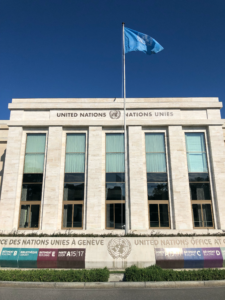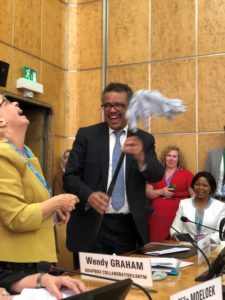Thoughts and Reflections from the 72nd World Health Assembly
July 25, 2019
By: James Stix, Partnerships & Strategy, Wellbeing Foundation Africa
 The World Health Assembly is somewhat of a yearly family reunion for the international health community. After seventy-two of them, plenty has changed while some aspects have remained the same. The first Assembly took place in 1948, shortly after the WHO’s inception, when the key decisions for the governance and development of the Organisation were still pending and 48 member states attended. It was still over a decade until the WHO actioned on the 1959 proposal towards a global initiative to eradicate smallpox and it was acting upon the importance of “enlisting the co-operation of governments and of non-governmental organisations in the collection and distribution of information”.
The World Health Assembly is somewhat of a yearly family reunion for the international health community. After seventy-two of them, plenty has changed while some aspects have remained the same. The first Assembly took place in 1948, shortly after the WHO’s inception, when the key decisions for the governance and development of the Organisation were still pending and 48 member states attended. It was still over a decade until the WHO actioned on the 1959 proposal towards a global initiative to eradicate smallpox and it was acting upon the importance of “enlisting the co-operation of governments and of non-governmental organisations in the collection and distribution of information”.
Today, the World Health Organisation has 150 country offices with multiple liaison offices and the ‘World’ in its name seems much more appropriate. Between the 20th and 28th May 2019, complementing the main functions of the World Health Assembly – to determine the policies of the Organization, appoint the Director-General, supervise financial policies, and review and approve the proposed programme budget – representatives from organisations across the world travelled to Geneva to host, join or collaborate on side events and sessions during the Assembly.
For the Wellbeing Foundation Africa, a maternal and newborn health-oriented NGO, the appeal of the Assembly brings in opportunities to connect, reconnect, expand and develop in a number of ways, some obvious and others more elusive. An early notion in planning to attend the Assembly is that convening globally-spread organisations, messages and impact to assess progress is difficult and so attendance has the benefits of being surrounded by the people we want to see, the partners we want to meet with and the leaders and decision-makers that bring about change.
This year, a primary focus of the Assembly for the Foundation was to join the water, sanitation and hygiene (WASH) in health care facilities resolution, which was unanimously approved and address a high-level meeting at the World Health Assembly on how to better align solutions to Women’s, Children’s and Adolescents’ Health and Well-being in Humanitarian and Fragile Settings, alongside meeting with partners, Ministers, world leaders and members of the international development community to further existing programmes and design new avenues for collaboration.
If it is not obvious from the above, the Assembly week becomes a whirlwind of activity and a flurry of movement. Aside from the larger implications (environmental, logistical, funding) of a legion of representatives and organisations travelling to Geneva for the Assembly, there is a conference fatigue which kicks in at around day two or three, especially if the Assembly comes off the heels of another conference of relevance to your organisation – which could have been anywhere from nearby Zurich to Sydney. This is where the efficacy of the Assembly comes into question and recent scrutiny has achieved some introspection – Devex wrote a great piece on the cost of development conferences for budgets and the environment – with some veteran attendees, such as executive director of the advocacy ONE Campaign, David McNair, making the point that today “I find you can save money, time, and cut your environmental footprint by following conferences on Twitter.”
Therefore, attending the World Health Assembly in 2019 happens at somewhat of a crossroads for the development community. There is a tangible, electric energy when you are in the room where progress becomes materialized at the global level, such as when Member States committed to developing national roadmaps, setting and monitoring targets, increasing investments in infrastructure and human resources and strengthening systems to improve and sustain Water, Sanitation and Health (WASH) services in health care facilities. That 32 countries spoke and highlighted the “fundamental role of WASH in Health Care Facilities (HCF) for achieving universal health coverage, improving quality of care and in preventing the spread of antimicrobial resistance” (UN Communiqué) truly feels like the culmination of combined efforts – it is both a humbling and empowering experience to cross eyes with partners and friends who you have worked with – sometimes programmatically on the frontlines and other times remotely – as Dr. Tedros walks in with a mop and turns the room to a cheerful celebration of progress made and the impact of an honest realisation from the WHO leadership of the work that remains to be done.
Reminiscing over such experiences reinforces the impression that the Assembly becomes logged in memory as more of a broad-stroke blur than a fine brush caricature. The meetings blend in, the  sessions could have happened on Tuesday or Wednesday, was it in May again? There is only so much the brain can log in an organised manner. This, however, is not to say that concrete outcomes do not bear fruit out of all these interactions and the Assembly is certainly a conference where both seeds are planted and fruits are harvested. This is where the surface chaos takes form onto the intricate, nuanced resolutions that are woven in the fabric of such a large-scale conference. The examples of outcomes vary widely: maybe you wanted to arrange a first meeting with a potential collaborator, or with the UN or WHO official responsible for the area of remit of you or your organisation, or maybe you wanted to attend a particular session that could strategically bolster your mission or work. The Assembly, beyond what’s on paper long before the first session inside the United Nations headquarters or at a nearby hotel hosting side meetings, is truly what you make of it.
sessions could have happened on Tuesday or Wednesday, was it in May again? There is only so much the brain can log in an organised manner. This, however, is not to say that concrete outcomes do not bear fruit out of all these interactions and the Assembly is certainly a conference where both seeds are planted and fruits are harvested. This is where the surface chaos takes form onto the intricate, nuanced resolutions that are woven in the fabric of such a large-scale conference. The examples of outcomes vary widely: maybe you wanted to arrange a first meeting with a potential collaborator, or with the UN or WHO official responsible for the area of remit of you or your organisation, or maybe you wanted to attend a particular session that could strategically bolster your mission or work. The Assembly, beyond what’s on paper long before the first session inside the United Nations headquarters or at a nearby hotel hosting side meetings, is truly what you make of it.
Therefore, the 2019 World Health Assembly was, if one aspect stands out for the Wellbeing Foundation Africa and its attending representatives, it was the Assembly on WASH. A year ago, at the 71st Assembly, we were setting up the meetings that we thought would lay the groundwork for work that could go on for years or decades in this area. A year later, having established partnerships with the WHO WASH teams, the World Bank, global corporations and advocacy groups and local implementing partners, we see the results of collaborative effort and a mass drive across the development sector – or the WASH-focused parts at least – towards greater investment and attention in providing water, sanitation and hygiene to healthcare facilities where most of our programmes take place. In an ever-changing environment where progress in impact is palpable but also assessing what the best way to structure the international development conference agenda is becoming a priority, we guess the fondue will have to wait until next year and the 73rd Assembly.